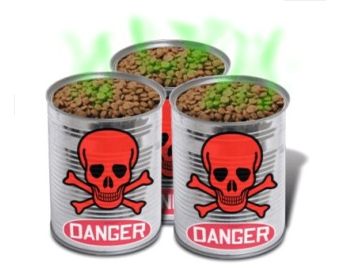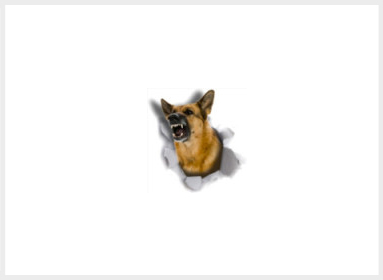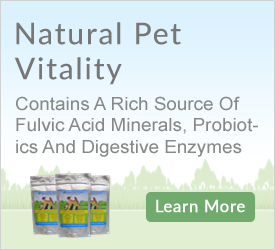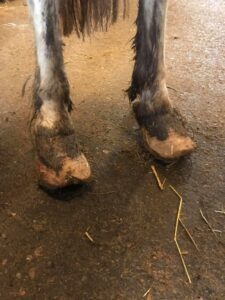
Laminitis – it’s the word every horse owner on the planet dreads. It has the ability to raise its ugly head at times in the most unlikely of places.
You’ve been strip grazing your pony for months. The paddock is positively burned dry and all throughout Spring she was boxed up at the worst of times – you did your reading, you knew all about the risks of high sugar spikes in the grass and dawn and dusk – and yet still your pony founders.
It’s the middle of winter and the grass stopped growing months back however, as the vet investigates the cause of your horse’s lameness, the L-word comes up once more.
What is laminitis?
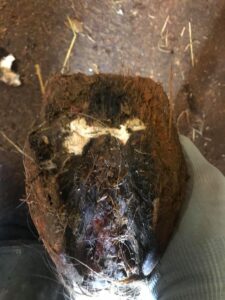 Laminitis (also termed founder) is inflammation of the laminae of the foot – the soft tissue structures that attach the coffin or pedal bone of the foot to the hoof wall. The inflammation and damage to the laminae causes extreme pain and leads to instability of the coffin bone in the hoof.
Laminitis (also termed founder) is inflammation of the laminae of the foot – the soft tissue structures that attach the coffin or pedal bone of the foot to the hoof wall. The inflammation and damage to the laminae causes extreme pain and leads to instability of the coffin bone in the hoof.
In more severe cases it can lead to complete separation of and rotation of the pedal bone within the hoof wall.
Laminitis is a crippling condition which can be fatal in severe cases. Once a horse has had an episode of laminitis, they are particularly susceptible to future episodes.
Each year thousands of horses are needlessly put to sleep because of hoof deformities that cause lameness, necrosis, gangrene and ultimately, much suffering.
If the owners had only known about trace minerals in addition to the customary macro minerals in packaged feed and in salt licks, over 90% of these abnormal hoof growth, deformities and abscesses could have been prevented.
It can be the most frustrating situation to find yourself in – feeling you’ve done your utmost to protect the beloved equine in your life only to find you are facing the battle to ease their pain and discomfort all over again.
So what can we do to help our horses stay well, particularly when advice comes from multiple sources and some of it is conflicting? Well, do not despair, there is a great deal we can do and in this article we will be discussing alternative treatments as well as one that’s relatively new to the UK market.
What can we do?
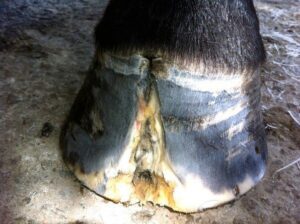 If like me, you would prefer to limit intervention from vets and pharmaceutical companies in favour of getting to the root cause of the issue, thereby limiting the likelihood of future attacks; homeopathy, farriery, holistic health and a supportive environment are the way forward.
If like me, you would prefer to limit intervention from vets and pharmaceutical companies in favour of getting to the root cause of the issue, thereby limiting the likelihood of future attacks; homeopathy, farriery, holistic health and a supportive environment are the way forward.
Several of the major factors in helping a laminitic horse are to support their feet properly, correct the intestinal health, provide nutritional medicine to prevent and reverse damage to the lamina, and to return the horse’s metabolism to proper balance.
There are so many factors to consider but more and more research points us to the gut for the overall physical and emotional wellbeing of our horse. Since in all beings, mind and body are so intrinsically linked, everything from mental stress factors to the environment in which the horse lives must also be considered.
For example, did you know that the pesticides a neighbouring farmer is using on their crops could be entering your horse’s food and water supply and affecting his microbiome? A horse needs friends, space, and play as well as exercise to be healthy in mind and as organic a diet as possible limits the chances of building up toxins in the body.
In the UK we are blessed with a wide range of suppliers of organic, grain free feeds; Equinatural, Thunderbrooks and Simple Systems are to name but a few.
Intestinal health and feeding
Horses with laminitis are often in extreme amounts of pain. This is a distressing situation for both horses and owners and often, we look for a way to deal with it as quickly as we can. As a result, high doses of non-steroidal anti inflammatories (NSAIDs) are often used over long periods of time.
This masks the pain the horse is actually feeling, catching us in the trap of using them for prolonged periods of time. Research has been done regularly on the effects of NSAIDs and toxicity both in the horse as well as in humans.
One recent equine study showed inflamed small and large intestinal walls after 12 days of phenylbutazone administration.
Since high doses of the NSAIDs are detrimental to the integrity of the intestinal wall the drugs may contribute to a leakage of bacteria across the wall that triggers part of the breakdown of the laminae increasing the devastation that the disease can cause. Their use therefore, should be questioned.
Dr Judy Harman of Harmany Equine says, “Clinically, in my experience the removal of the NSAIDs is one of the most important aspects of the success of the holistic treatment. The horses’ symptoms are usually worse for three to five days after removing the NSAIDs, so they lie down more.
That can be alarming to the owners and attending veterinarians, however, it is best for the horse, since the pressure is off the feet. The antioxidants can then work.
When a horse feels better with natural medicine it is because he is better, not because the pain is masked.
Clinically I have found laminitis horses respond best when an attempt is made to repair the damage done by NSAIDs.”
Insulin Resistance
A relatively new condition is being recognised in human medicine, currently called syndrome X. This is a group of symptoms related to insulin resistance or hyperinsulinemia and an inability for the cells to transport glucose into them.
The disease commonly called “Cushing’s syndrome” in horses has many of the same characteristics as syndrome X has in people.
Many laminitis horses have elevated insulin levels in their blood. The reason the insulin is elevated is that it is not able to get into the cells. Normally when a sugar or carbohydrate is eaten, the blood sugar levels increase, insulin is secreted by the pancreas, glucose is carried into the cells by the insulin and the blood sugar goes back to normal. In insulin resistance, the cell walls are too stiff to let the insulin do its job properly.
So the glucose, instead of providing energy for the cells, gets stored as fat.
People that are susceptible to syndrome X are from a genetic type considered “thrifty” or in horse terms, “easy keepers.” In this type of individual, horse or human, the body is very efficient at storing fat for times of need, and in fact, if fed less, they often become more efficient at storing fat.
In humans much of the fat stored from impaired glucose metabolism is distributed centrally, especially around the abdomen. Many horses store their fat in specific places; fat pads on their body and cresty necks.
So what’s the solution?
The basic protocol in treating people with Syndrome X contains many of the ingredients used when treating the chronic laminitis horse. The idea is to help make the cell walls be more permeable to insulin and to provide nutrients to help the insulin and glucose pathways function better. The good news is, along with naturally chelated trace minerals and good husbandry, fulvic acid can do both these jobs.
What is fulvic acid?
A fairly recently researched and investigated phenomenon, fulvic acid is by far means new. It is naturally formed over millions of years as part of the carbon cycle, the same process which forms coal, and even diamonds.
It’s a mineral that is extracted from a highly nutritious layer of the earth called the humus, the organic matter in soil. We’re not talking about the dip you may have heard of, this humus is the layer of the earth where millions of beneficial microbes go to work on the decaying plant matter creating the Fulvic, which in turn helps feed grazing animals and helps to ensure that they grow healthy and strong.
Fulvic acid is one component of humus.
Humus is made of many organic compounds found in the Earth’s soils, rock sediments and bodies of water.
Over the past several decades, we’ve learned a lot more about how fulvic acids found in dirt can actually improve human gut health and therefore immune functions.
Today people supplement with fulvic acid, as well as soil-based probiotics, to replenish what is being lost in their diets and lifestyles due to modern farming techniques.
While people used to obtain higher amounts of humic acids naturally from the soil, today they often turn to food-grade supplements to boost their nutrient intake and improve gut health.
What does it do?
Nicola Brown of Natural Fulvic Vitality says, “One of the most powerful tools mother nature has given us is the fulvic acid molecule. Coined ‘mother nature’s miracle’ as such because it has the incredible ability to perform so many functions of which the body is in desperate need. Dr Jackson has truly brought us a gift with his special formula.”
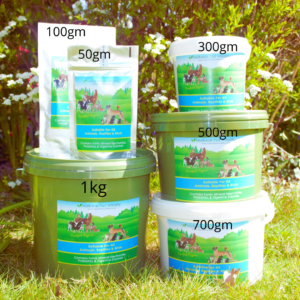 Natural Pet Vitality is a special formula which aids specifically in detoxifying and mineralising the body both at the same time brings it into such a healthy place that it becomes a hostile environment to illness, disease and parasites.
Natural Pet Vitality is a special formula which aids specifically in detoxifying and mineralising the body both at the same time brings it into such a healthy place that it becomes a hostile environment to illness, disease and parasites.
This magical formula, helps your animal better cope with environment pollutants and toxicity – a contributory factor in the laminitic horse converting food into muscle and recovery from severe work load, injury, sickness and pregnancy.
Some of the benefits of Natural Pet Vitality Fulvic Minerals reported during our field trial studies included:
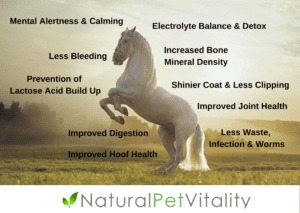
It helps by stabilising the micro-flora in the gut which may lead to an improvement in the animal’s behaviour
Assisting in improving food conversion which may lead to a reduction in feed costs
Boosting the immune system
Providing the daily essential vitamins, minerals and trace elements needed for good health and wellbeing of your animal
Rebuilding and strengthening connective tissue: ligaments, tendons, joints
Improving pain management and increased levels of energy
Highly bio-available, being readily absorbed into the animal’s system
The role of trace elements in healing
Additionally, remedial surgeries, due to poor hoof formation, can be obviated if a horse gets a balanced supply of essential trace elements. Certain colloidal minerals with naturally-chelated trace elements have properties to remineralise undernourished horses and supply essential trace elements along with their catalytic properties.
Silicon for example, is an element very prevalent in the heart and also is extremely important for the restoration of damaged tissues. It was discovered to act synergistically with calcium and phosphorous to lend structural integrity to plants, and in conjunction with Vitamin D, to speed the recalcification of bones. One of the best sources not only of microminerals and naturally-chelated trace minerals but also, fulvic acid.
Because fulvic acid is able to improve how our cells use things like antioxidants and electrolytes, it’s become popular for slowing down aging, improving digestive health and protecting brain function. In fact studies, now show that fulvic acid has antioxidant, neuro-protective, antimicrobial and anti-inflammatory properties – all of which are crucial for healing from laminitis.
What does fulvic acid do for the body exactly?
As an active chemical compound, it works in a way that helps us absorb and use other nutrients better — such as microbiota/probiotics, phytonutrients, fatty acids and minerals. Many consider it to be the ultimate “nutrient booster,” and it helps counteract free radical damage.
Fulvic acid and other humic acids are yellow-brown substances found in natural materials.
They contain a plethora of nutrients and active compounds that can help improve health.
These include:
Trace minerals
Electrolytes
Fatty acids
Silica (which boosts collagen synthesis)
Prebiotics
Probiotics
Fulvic minerals have been shown to contain multiple active functional groups, including phenolic hydroxyl, ketone carbonyl, quinone carbonyl, carboxyl and alkoxyl groups.
Its structure is made up of aromatic, organic polymers with many carboxyl groups that release hydrogen ions, resulting in an electric charge that helps attract free radicals, heavy metals and other toxins within the body. This allows it to act like a detoxification agent.
Once it becomes reactive with metals, fulvic acid helps them become more soluble in water, which means they’re carried out of the body more easily.
Environmental Factors
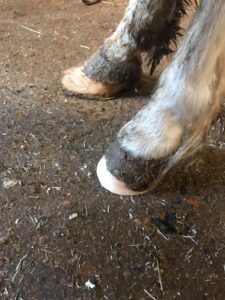
Photo credit: Harwell Diemling Farrier Brighton
In addition to supplementation, we can support the horse with good barefoot trimming, the track system environment, keeping stress to a minimum by working on the premise of the three F’s (freedom, forage, friends), regular de-toxing and other complementary therapies such as reiki, acupuncture, bioresonance, zoopharmacognosy and a natural, grain free diet.
Thunderbrooks has a fantastic range of organic feed products to specifically support the detox process and there is now an ever growing range of organic feed suppliers to choose from enabling you to reduce the likelihood of toxic build-up in the first place. Equinatural, Simple Systems and Allen and Page are just a few examples.
Herbal Help
Help can also be sought from our herbal friends. Milk thistle is a wonderful detox for the liver and Slippery Elm is fantastic for cleansing the gut.
Catherine Bird of Country Parks Animal Herbs says, “Normal blood flow through the foot may be mildly or severely altered. Herbs can assist greatly in this circumstance by promoting healthy circulation. Hawthorn berry and Bilberry assists with blood flow and pressure, especially peripheral circulation.
If your horse develops infections and abscesses in their feet, a garlic and hawthorn blend works well. Adding pain-relieving herbs such as white willow and devil’s claw is also helpful. Celery seed has anti-inflammatory action and helps improve the appetite. Chamomile is anti-inflammatory and improves circulation and digestion. Comfrey leaf helps soothe inflamed tissues and promotes fast healing.
Among the herbs beneficial for strengthening the hoof and encouraging the growth of healthy hoof and tissue are kelp, rose hips and garlic.”
The long and the short of it is that there is no quick fix to the laminitis problem but trust that by following these protocols, you will be getting to the root of the problem and likely extending and improving the life quality hugely for your best equine friend.
Article written by Nicola Carley
Natural Fulvic Vitality
Image Credit: Harwill Diemling, Brighton Farrier.
Order Natural Pet Vitality Here

